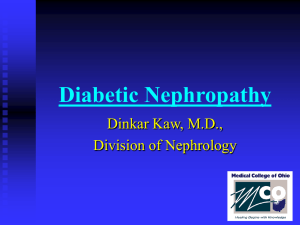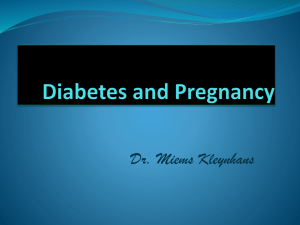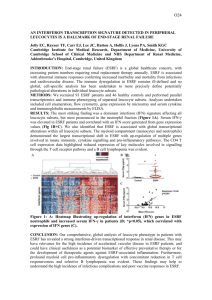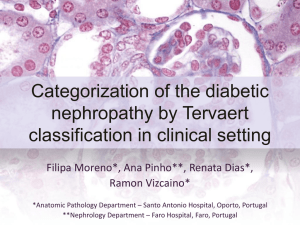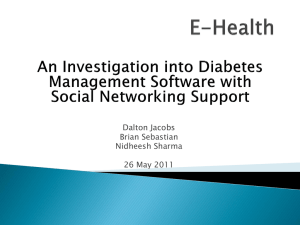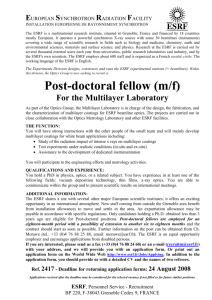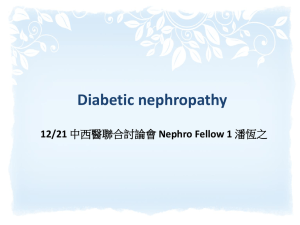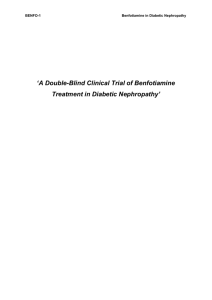Diabetic renal disease - Diabetes in Berkshire West
advertisement
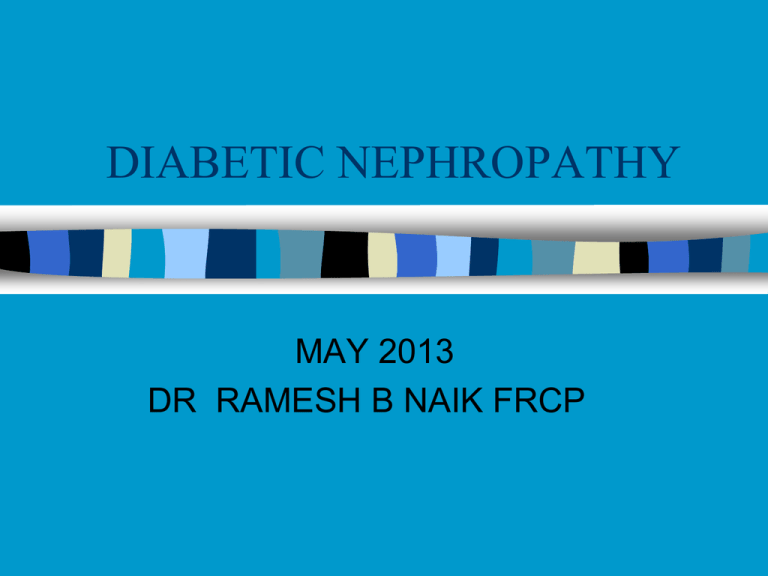
DIABETIC NEPHROPATHY MAY 2013 DR RAMESH B NAIK FRCP Causes of ESRF in Patient Starting Dialysis UK (%) Diabetes Glomerulonephritis 30 12 Pyelonephritis Polycystic Kidney Disease 9 10 Hypertension Renovascular disease Uncertain Others 8 6 17 8 Acceptance Rates for RRT • 100-120 pmp/yr in UK • USA – Whites 185 pmp/yr Blacks 758 pmp/yr Total – 242 pmp/yr Berkshire is 114 but Slough is 143 pmp/yr Age • 1982 11% over 65 years old • Now 50% - will be more • Liberalisation of attitudes PREVALENCE OF DIABETES Percentages All ethnic minorities 5.6 Caribbean 5.9 All South Asians 5.9 Indian 5.5 African Asian 4.0 Pakistani 7.6 Bangladeshi 7.4 Chinese 2.2 White 2.2 Diabetic Renal Failure - Incidence • • Commonest cause of ESRF & rising Major implications for dialysis programmes Europe • • USA 1976 3% 1985 11% 1992 17% 1993 22% 36% 2004 25-30% 40-45% 1985 60% type I 1993 60% type II 23% Diabetic RF - Pathology Four Stages:• • • • Hypertrophy / hyperfiltration Microalbuminuria Diabetic glomerulosclerosis ESRF Microalbuminuria in Guidelines Existing UK guidance • Joint British Societies 2 Guidelines (2005) Recognise MAU, proteinuria and CKD as TOD CKD defined by eGFR levels Patients with raised blood pressure and TOD should be considered high risk and be managed accordingly Diabetes and TOD – BP target 130/80 mm Hg What is Microalbuminuria? Definitions and prevalence • Levels of urinary albumin above the normal range, but lower than dipstick-positive proteinuria below are termed microalbuminuria • Microalbuminuria is found in: • 5-7% of the ‘healthy’ population • 12-30% of the hypertensive population Morning urine sample (mg/l) Morning urine sample – Albumin to Creatinine Ratio (mg/mmol) <20 Males <2.5 Females <3.5 Microalbuminuria 20-200 Males 2.5-25 Females 3.5-25 Macroalbuminuria (proteinuria) >200 Males >25 Females >25 Normal Microalbuminuria: both risk marker and independent risk factor Presence of Microalbuminuria Increased Risk of Renal Complications Increased Risk of New Onset Diabetes Increased Risk of Cardiovascular Events GUIDELINES FOR DIABETIC RENAL DISEASE Persistent Microalbuminuria earliest marker of diabetic nephropathy Associated with increased risk of Retinopathy Cardiovascular disease Reversible in up to 50% if treated early ANNUAL PROTEIN DIPSTICK If negative, EMU for ACR If ACR positive, repeat 2x within 12 weeks If negative, repeat annually If positive dipstick proteinuria, or positive ACR WE MUST DO SOMETHING WHAT DO WE DO All patients (regardless of BP) Add ACEI/ARB (Check Renal Function) To maximum dose Lifestyle modification Diet (Dietician) Exercise Smoking cessation Glycaemic control ( HbA1C <7% ) BP 130/80 (or 125/75 if proteinuria >1gm) Which drugs ( CaCB Diuretics BB ) Aspirin. Statin Metformin. Fibrates ( Avoid or Stop ) Renal Clinic Urine protein >1gm/24 hrs Creatinine >150mmol//litre Diagnostic uncertainty Diabetes Clinic Difficulty achieving BP or HbA1C Persistent dyslipidaemia DIABETIC NEPHROPATHY • • • • • DM more common in Europe and North America Long induction of 20-30 years from onset DM to RF Increased prevalence DM not impacted on numbers. Tidal wave yet to come! Lifestyle of increasing inactivity and high calorie intake favours development of T2DM in genetically susceptible individuals • Ageing population has exposed more individuals to risk, decreasing mortality from CV causes means more survive to get ESRF Genetic Factors are Important • Some Ethnic groups have higher incidence of DM and diabetic nephropathy • AA and native Americans in USA, A-C in Caribbean and UK, South Asians worldwide, every Polynesian population • Higher incidence of older people in some regions of Germany e.g. in lower Neckar region 50% of dialysis population ESRD IN DIABETES[2009] A. New pts with DM developing ESRD 44% in USA and 25% in UK B. Incident no. of patients in USA 355 pmp cf 110pmp in UK C. No. of prevalent patients rising. 572000 on ESRD RX [half DM] in USA; 50000 in UK [17.5% DM] D. Survival with ESRD and DM at 1 yr on dialysis 2002 76% 2009 84% DIABETIC NEPHROPATHY OBESITY, DM AND THE KIDNEY Natural History of Type 2 Diabetic Nephropathy Clinical type 2 diabetes Functional changes* Structural changes† Rising blood pressure Microalbuminuria Proteinuria Rising serum creatinine levels End-stage renal disease Cardiovascular death Onset of diabetes 2 5 10 Years * Renal haemodynamics altered, glomerular hyperfiltration † Glomerular basement membrane thickening , mesangial expansion , microvascular changes +/- 20 30 Prevalence of Diabetes amongst ESRF • UK Renal Registry report 2004 Comorbidity at start of RRT % incidence Cardiovascular disease 24.7 Cerebrovascular disease 11.7 Peripheral vascular disease 14.2 Diabetes (not cause of ESRF) 7.4 Diabetic nephropathy 18.8 Diabetes (either category) 26.1 No comorbidity 38.7 Mortality in Diabetic ESRF • 5 year survival on dialysis 20% • 5 year survival on transplantation 75-80% • Causes of death • CVS disease 50% • Infection 15-20% • Withdrawal from dialysis 20% • Mailloux et al.JASN 1993;3(9) 65% of patients were >61 years at start of dialysis 50% of patients had diabetes and/or renovascular disease Mortality in Diabetic ESRF • Joanna Johnson et al.NDT 1999;14:2156-64 • Quantitative metaanalysis • RR of death in dialysis patients • • • • 1.029 with each year of increasing age 1.59 with cardiovascular disease 1.58 with peripheral vascular disease 1.91 with diabetes • UK Registry report 2004 –RR of death at 1year was 1.65 with diabetes Epidemiology of Cardiovascular Disease in Haemodialysis Patients 100 10 1 0.1 0.01 25-34 35-44 45-54 55-64 65-74 75-84 >85 Age (years) Dialysis M Dialysis F Healthy M Healthy F Foley AJKD 1998;32:S112-9 WET GANGRENE Distal Calcific Uremic Aeteriolopathy (CUA) 2/24/00 3/9/00 Anterior Leg (SHIN) 3/24/00 CVD Mortality by Urinary Protein Excretion in Type 2 Diabetes A: U-Prot <150 mg/L B: U-Prot 150–300 mg/L C: U-Prot >300 mg/L 1.0 Survival curves for CVD mortality 0.9 A 0.8 B 0.7 0.6 0.5 0 U-Prot = urinary protein concentration C Overall: p<0.001 0 10 20 30 40 50 60 70 80 90 Months Miettinen H et al. Stroke. 1996; 27: 2033–2039. Valsartan lowers AER in type 2 diabetic patients with microalbuminuria 65 Mean AER (g/min) 55 45 35 25 Percent change of AER (%) Valsartan Amlodipine 20 10 0 -10 -20 -30 -40 -50 p<0.001 (changes in logged UEAR from baseline at week 24) 9 8.8 HbA1c (%) 8.6 8.4 8.2 8 0 4 8 12 time (wks) 18 24 IRMA 2 Normalisation of Urinary Albumin Excretion Rate at 2 years (<20 g/min) 45 p=0.006 40 35 Subjects (%) 34 30 25 20 21 24 15 10 5 0 Control (n=201) 150 mg (n=195) 300 mg (n=194) Irbesartan 30 Parving H-H, et al. N Engl J Med 2001; 345(12): 870-878. IRMA 2 Primary Endpoint Development of Diabetic Nephropathy 18 16 14 14.9 Subjects 12 (%) 10 RRR=70% p<0.001 RRR=39% p=0.08 9.7 8 6 5.2 4 2 0 Control (n=201) 150 mg (n=195) 300 mg (n=194) Irbesartan 31 Parving H-H, et al. N Engl J Med 2001; 345(12): 870-878. IDNT: Time to Doubling of SeCr 70 Irbesartan (n=579) RRR=37% P<.001 RRR=33% Amlodipine (n=567) P=.003 P=NS Control (n=569) 60 Patients (%) 50 40 30 20 10 0 0 6 12 18 24 30 36 Follow-up (months) 42 48 54 Control defined as placebo SeCr, serum creatinine; RRR, relative risk reduction Adapted from Lewis EJ et al. N Engl J Med. 2001;345:851-860. Summary • Diabetic Nephropathy accounts for significant proportion of ESRF • Increasing number of sick older diabetics • Mortality higher compared to non diabetics • Early intervention important to reduce complications associated with disease Dialysis related problems • Difficult vascular access • Haemodynamic instability due to autonomic neuropathy • Increased infection • Unpredictable blood sugars • • • • • Increased insulin sensitivity Increased insulin degradation Increased insulin secretion Decreased clearance of oral hypoglycemics Hyperglycemia from PD dialysate( 83 mmol/L in 1.36%) • Weight gain on PD Prevalence of Diabetes amongst ESRF • Proportion of diabetics amongst ESRF US 45% Germany 36 % Australia 22% • Increasing proportion of Type 2Diabetes entering RRT (+11.9% annually data from European registry 1991-1999) • Increasing number of older patients due to better survival • Incidence of ESRF decreasing amongst Type 1 diabetes- Nishimura et al AJKD 2003;42(1) Time Course of Type 2 Diabetic Renal Disease PRIME Prevention Protection IRMA 2 IDNT Microalbuminuria Proteinuria ESRD Cardiovascular Morbidity and Mortality Early Stage Late Stage Kidney Disease End Stage
